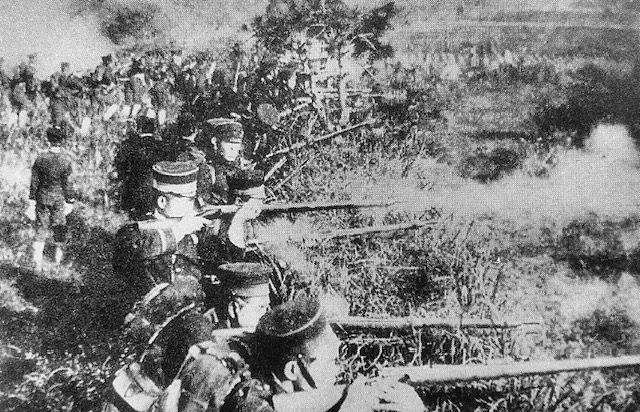shijitu「史実を世界に発信」
【概説】「史実を世界に発信する会」 茂木弘道
『大東亜戦争への道』(展転社)
中村 粲
その4 第二章 第一節 日清戦争:開戦と戦況の推移

日清戦争の原因となった東学党の乱は、農民一揆が政治暴動化したものです。しかし、この東学党が、一方で閔氏一派の打倒の機を窺う大院君と通じ、他方、清公使袁世凱とも通じていたところに問題が伏在していました。
清は出兵します。天津条約に従って出兵通告をしてきましたが、その中に「属邦保護」という言葉がありました。これは、日本の対韓政策の根本と相いれない問題です。日本は条約に従って清国兵力との均衡を保つために出兵します。
日本は朝鮮国王に5項26条の内政改革の勧告を行います。過去10年にわたって朝鮮属邦化政策を進めてきた袁世凱をバックに朝鮮政府はこれに抵抗します。日本は期限付き回答を求め、期限を過ぎた7月22日、景福宮内の朝鮮兵を駆逐しました。閔氏一族は逃走し、大院君が日本公使の要望で政権に復帰します。7月25日、大院君は、清韓宗属関係の廃棄を宣言し、牙山駐屯の清兵駆逐を我が国に要請しました。
7月29日、日本軍は成歓に清軍を破り、牙山を占領しました。8月1日、日清両国は互いに宣戦布告を行いました。宣戦布告の中で日本は、「朝鮮は独立国であり、日本は内政改革を勧告したのを受け入れたにもかかわらず、清国は内政干渉して妨害した」と述べています。一方、清は「朝鮮は我が大清の属藩たること200余年」と主張しています。まさに進取と守旧の対決でした。
9月16日、日本軍は平壌を占領。17日、海軍は黄海で北洋艦隊を撃破。
10月に入り、第1軍は鴨緑江を超えて満洲に進み、下旬には九連城、鳳凰城を陥落させます。第二軍も10月24日、遼東半島の花園口に上陸し、錦秋・大連湾を攻略、11月21日には旅順を占領します。
清は敗残の軍艦を山東半島北岸の威海衛に集結したため、陸海よりこれを攻撃することとし、明治28年の1月末、山東半島東端の栄城湾に上陸、1日で威海衛の砲台を占領しました。海軍は2月初旬、水雷攻撃で旗艦定遠、北洋艦隊の大部分を撃破、北洋艦隊は全滅しました。
3月に入ると、牛荘を占領、ついで田庄台に2万の清軍を破り、まさに首都北京に迫ろうというところまで来ました。
・その4,第2章1節 日本語原文: http://hassin.org/01/wp-content/uploads/Road4.pdf
・ 〃 第2章1節 英訳文: http://www.sdh-fact.com/CL/Road4E.pdf
令和4年10月6日
「史実を世界に発信する会」 会長 茂木弘道
協力者代表:神奈川大学教授 小山和伸
*拡散大歓迎
THE ROAD TO THE GREATER EAST ASIAN WAR
Nakamura Akira, Professor Emeritus of Dokkyo University
(English Translation: Society for the Dissemination of Historical Fact)
Part 4: Chapter 2 The 1st Sino Japanese War -1
The principal cause of the 1st Sino-Japanese War was the Donghak Peaqsant Revolution, p peasant revolt that evolved into a political. The problem was that the Donghak Party colluded with Daewongun (who was desperate for an opportunity to displace Wueen Min and her followers) and with Yuan Shikai, the Chinese plenipotentiary.
The Chinese were the first to send troops to Korea, on June, 1894. They immediately notified the Japanese. In accordance with Convention of Tsientsin. But in the notice, the Chinese stated that they were doing so to protect their “vassal state,” which contravened the basis of Japan’s Korean policy. Japan immediately protested and dispatched the same number of men to Korea as China.
On July 3 Japan proposed to reform proposal consisting of 26 articles. With prompting from Yuan Shikai the Korean government voiced strenuous opposition. On July 20, Japanese Diplomat Oshima to respond by July 22. Korea submitted a stopgap reply and Oshima warned the Koreans that he would take military action if he did not receive a satisfactory response. On July 23the Japanese military expelled Korean soldiers from Gyonbok Palace. Queen Min and her family members fled, and Daewongun agreed to head the government upon Oshima’s request. On July 25, Daewongun announce the termination of the suzerainty relationship with China, and demanded that Chinese troops stationed I Asan withdraw from Korea.
On July 29, Japanese forces defeated the Chinese in a land battle at Seonghwan, and occupied Asan. On August 1 both Japan and China issued declaration of war. In the declaration of war, Japan states that Korea is an independent nation. Korea has already consented to undertake reform but China endeavoured to circumvent and to thwart Japan. While China states that Korea has been our tributary for the past two hundred years. The two stances reflect the conflict between the progressive and conservatives.
On September 16, The Japanese occupied Pyongyang. On September 17, the Japanese vanquished the Beiyang Fleet in the Yellow Sea. In early October Japan’s First Army crossed the Yalu River into Manchuria, near the end of the month conquered Jiulian and Fenghuan. The Second Army landed at Huayuankou on Liatong peninsula and captured Jinzhou and Dalian Bay on October 24 and occupied Lushun on November 1.
At the end of January 1895, the Japanese landed at Rongcheng Bay on the east coast of Shandong peninsula, and occupied the battery at Weihaiwei after only one day’s fighting. In early February the Navy used torpedoes to sink Dingyuan, the flag ship and many ships and destroyed Beiyang Fleet completely.
The First Army occupied Yingkou in early March, and then proceeded to defeat 20,000 Chinese troops at Tianzhuangtai. The First and Second armies then marched together to Peking, the capital.
URL: https://www.sdh-fact.com/book-article/1970/
PDF: http://www.sdh-fact.com/CL/Road4E.pdf
MOTEKI Hiromichi, Chairman
Society for the Dissemination of Historical Fact
Phone: 03-3519-4366
Fax: 03-3519-4367
Email moteki@sdh-fact.com
Note: Japanese names are rendered surname first in accordance with Japanese custom.
